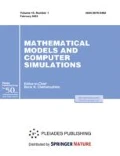Abstract
This study considers the problem of a firm, which makes decisions regarding investments, production, and payment of dividends to the owners of the firm in conditions of uncertainty in the timing of the transactions. The task is set for the manufacturing agent on a finite planning horizon. The approach used to solve the optimal control problem arising in the economic model is based on the method of Lagrange multipliers. Sufficient optimality conditions are formulated and a system of partial differential equations with a shift that determines the solution of the problem is derived. The solution to this system is obtained in the case of constant prices and interest rates, and in the general case, approximate solutions are obtained at a high transaction frequency. It shows the specifics of the problem compared to the problem on an infinite horizon due to the presence of a boundary layer in which the analysis can significantly change compared to the analysis of the solution within the planning horizon. This model might be used as a block of a manufacturing agent in applied modeling of the computable intertemporal equilibrium of a country’s economy.
Similar content being viewed by others
Notes
\(\mathbb{L}\mathbb{C}\) denotes the space of the left continuous bounded functions.
REFERENCES
G. C. Chow, “The Lagrange method of optimization with applications to portfolio and investment decisions,” J. Econ. Dyn. Control 20 (1–3), 1–18 (1996).
G. C. Chow, Dynamic Economics: Optimization by the Lagrange Method (Oxford Univ. Press, Oxford, 1997).
G. C. Chow, “Optimal control without solving the Bellman equation,” J. Econ. Dyn. Control 17 (4), 621–630 (1993).
M. Yu. Andreev, V. P. Vrzheshch, N. P. Pil’nik, I. G. Pospelov, M. A. Khokhlov, A. A. Zhukova, and S. A. Radionov, “Intertemporal general equilibrium model of the Russian economy based on national accounts deaggregation,” J. Math. Sci. 197 (2), 175–236 (2014).
N. P. Pilnik, I. G. Pospelov, S. A. Radionov, and A. A. Zhukova, “The intertemporal general equilibrium model of the economy with the product, money and stock markets,” Int. J. Comput. Econ. Econometrics 4 (1–2), 207 (2014).
M. A. Khokhlov, I. G. Pospelov, and L. Y. Pospelova, “Technology of development and implementation of realistic (country-specific) models of intertemporal equilibrium,” Int. J. Comput. Econ. Econometrics 4 (1–2), 234 (2014).
A. A. Petrov and I. G. Pospelov, “Mathematical models of the Russian economy,” Herald Russ. Acad. Sci. 79 (3), 205–216 (2009).
I. G. Pospelov and M. A. Khokhlov, “A dimension verification method for studying models of economic dynamics,” Mat. Model. 18 (10), 113–122 (2006).
B. K. Øksendal and A. Sulem, Applied Stochastic Control of Jump Diffusions (Springer, Berlin, 2007).
S. Rong, “Optimization for a financial market with jumps by Lagrange’s method,” Pac. Econ. Rev. 4 (3), 261–276 (1999).
S. Rong, Theory of Stochastic Differential Equations with Jumps and Applications: Mathematical and Analytical Techniques with Applications to Engineering (Springer, Berlin, 2006).
A. A. Zhukova and I. G. Pospelov, “A stochastic model of trade in illiquid goods,” Tr. Mosk. Fiz.-Tekh. Inst. 4 (2), 131–147 (2012).
A. A. Zhukova and I. G. Pospelov, “An optimal consumption model in the presence of the possibility of lending at random times,” Ekon. Zh. Vyssh. Shk. Ekon. 22 (3), 330–361 (2018).
R. F. Harrod, “An essay in dynamic theory,” Econ. J. 49 (193), 14–33 (1939).
E. D. Domar, “Capital expansion, rate of growth, and employment,” Econometrica 14 (2), 137 (1946).
D. Acemoglu, Introduction to Modern Economic Growth (Princeton Univ. Press, 2009).
I. G. Pospelov and N. P. Pil’nik, “On natural terminal conditions in models of intertemporal equilibrium,” Ekon. Zh. Vyssh. Shk. Ekon. 11 (1), 1–33 (2007).
A. A. Zhukova and I. G. Pospelov, “Investigation of a stochastic model of savings with inertial consumption,” Tr. Mosk. Fiz.-Tekh. Inst. 6 (4), 41–48 (2014).
Funding
This study was supported by a grant from the Russian Foundation for Basic Research, project 17-01-00588 A, “Dynamic models of the economy with a random time step.”
Author information
Authors and Affiliations
Corresponding author
Rights and permissions
About this article
Cite this article
Zhukova, A.A. Model of the Manufacturer’s Behavior when Obtaining Loans and Making Investments at Random Moments in Time. Math Models Comput Simul 12, 933–941 (2020). https://doi.org/10.1134/S2070048220060186
Received:
Revised:
Accepted:
Published:
Issue Date:
DOI: https://doi.org/10.1134/S2070048220060186



